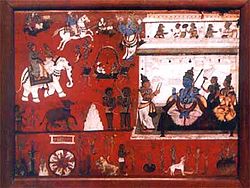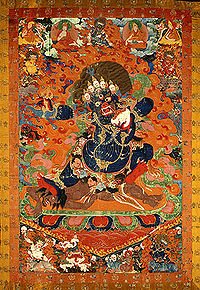- Yama
-
This article is about the Hindu and Buddhist deity Yama generally. For Yama in the Hindu tradition, see Yama (Hinduism). For Yama in the Buddhist and East Asian tradition, see Yama (Buddhism and Chinese mythology). For other uses, see Yama (disambiguation).
 Yama's Court and Hell.The Blue figure is Yama with his consort Yami and Chitragupta
Yama's Court and Hell.The Blue figure is Yama with his consort Yami and Chitragupta
17th century Painting from Government Museum, ChennaiYama (Sanskrit: यम), also known as Yamarāja (यमराज) in India and Nepal, Shinje (གཤིན་རྗེ།) in Tibet, Yanluowang (閻羅王) or simply Yan (閻) in China, Yeomla Daewang (염라대왕) in South Korea and Enma Dai-Ō (閻魔大王) in Japan, is the lord of death, in Hinduism and then adopted into Buddhism and then further into Chinese mythology and Japanese mythology. First recorded in the Vedas. The name Yanluo (simplified Chinese: 阎罗; traditional Chinese: 閻羅; pinyin: Yánluó; Wade–Giles: Yen-lo) is a shortened Chinese transliteration of the Sanskrit term यम राज Yama Rājā, or "King Yama". Enma Dai-Ō is a further transliteration, meaning "Great King Yama", where Enma means Yama, Enma-Ō means Yama Rājā and Enma Dai-Ō would be equivalent to यम महाराज Yama Mahārāja.
Yama belongs to an early stratum of Vedic mythology. In Vedic tradition Yama was considered to have been the first mortal who died and espied the way to the celestial abodes, and in virtue of precedence he became the ruler of the departed. Yama's name can be interpreted to mean "twin", and in some myths he is paired with a twin sister Yamī.
Contents
Eastern religion
Main article: Yama (Hinduism)Yama is a Lokapāla and an Aditya. In art, he is depicted with green or red skin, red clothes, and riding a water buffalo. He holds a loop of rope in his left hand with which he pulls the soul from the corpse. He is the son of Surya (Sun) and twin brother of Yami, or Yamuna, traditionally the first human pair in the Vedas. He was also worshiped as a son of Vivasvat and Saranya. He is one of the Guardians of the directions and represents the south. He reports to Lord Shiva the Destroyer, an aspect of Trimurti. Three hymns (10, 14, and 35) in the Rig Veda Book 10 are addressed to him. He has two dogs (cf. Hellhound) with four eyes and wide nostrils guarding the road to his abode. They are said to wander about among people as his messengers.[1] There is a one of a kind temple in Srivanchiyam, Tamil Nadu, India, dedicated to Yama.
The Vedic Yama, with certain changes of function, was the basis for the Buddhist Yama, judge of the dead, who presides over the Buddhist Hells. The Buddhist Yama became an integral part of Chinese and Japanese mythology. Although ultimately based on the god Yama of the Hindu Vedas, the Buddhist Yama has developed different myths and different functions from the Hindu deity.
Yama's abode
Naraka (Hindu)
Main article: Naraka (Hinduism)Naraka in Hinduism is not equivalent to Hell in Christian faith. Naraka is only a purgatory where the soul gets purified of sin by sufferings. In Hindu myth, there are many hells, and Yama, Lord of Justice, sends human beings after death for appropriate punishment. Even Mukti-yogyas (souls eligible for mukti or moksha), and Nitya-samsarins (forever transmigrating ones in Dvaita theology) can experience Naraka for expiation.
According to Hindu mythology, based on one's good and bad deeds, Yama decides which Naraka (lower world or hell) and/or Swarga (higher world or heaven) the soul needs to spend time in, before returning to Bhoomi (earth) - the only world from which the soul can permanently escape the birth and death cycle. Good and bad deeds don't cancel out each other, and thus the same soul may spend time in both a hell and a heaven, The seven Narakas are: Athala, Vithala, Suthala, Paathaala, Mahaadhala, Rasaadhala, Dharaadhala. The seven Swargas are: Bhuvas, Swas (governed by Indra), Tharus, Thaarus, Savithaa, Prapithaa, Maha (governed by Brahma).
Naraka (Sikhism)
The idea of Naraka in Sikhism is like the idea of Hell. One's soul, however, is confined to 8.4 million life cycles before taking birth as a human, the point of human life being one where one attains salvation, the salvation being sach khand. The idea of khand comes in multiple levels of such heavens, the highest being merging with God as one. The idea of Hell is like it comes in multiple levels, and hell itself can manifest within human life itself. The Sikh idea of hell is where one is apart from naama and gurus charana (God's lotus feet (abode)). Without naama one is damned. Naama is believed to be a direct deliverance from God to humanity in the form of Guru Nanak. A sikh is hence required to take the Amrit (holy nectar/water) from gurubani, panj pyare (khanda da pahul) to come closer to naama. A true Sikh of the Gurus has the Guru himself manifest and take that person into sach khand.
Naraka (Buddhist)
Main article: Naraka (Buddhism)Naraka is usually translated into English as "hell" or "purgatory". A Naraka differs from the hells of western religions in two respects. First, beings are not sent to Naraka as the result of a divine judgment and punishment; second, the length of a being's stay in a Naraka is not eternal, though it is usually very long. Instead, a being is born into a Naraka as a direct result of his or her previous karma (actions of body, speech and mind), and resides there for a finite length of time until his karma has exhausted its cumulate effect.
Di Yu (Chinese mythology) and Meido and Jigoku (Japanese mythology)
Main article: Di Yu and JigokuChinese Di Yu, Japanese Jigoku, literally "earth prison", is the realm of the dead or "hell" in Chinese mythology and Japanese mythology. It is based upon the Buddhist concept of Naraka combined with local afterlife beliefs. Incorporating ideas from Taoism and Buddhism as well as traditional religion in China, Di Yu is a kind of purgatory place which serves not only to punish but also to renew spirits ready for their next incarnation. This is interchangeable with the concept of Naraka. In Japanese mythology Enma-O or Enma Dai-O judges souls in Meido, the kingdom of the waiting dead. Those deemed too horrible are sent to Jigoku, a land more comparable to the Christian hell. It is a land of eternal toil and punishment. Those of middle note remain in meido for a period awaiting reincarnation. Others, of high note, become honored ancestors, watching over their descendants.
Related concepts
Yama and Ymir
Main article: YmirIn a disputable etymology, W. Meid (1992) has linked the names Yama (reconstructed in Proto-Indo-European as *yemos) and the name of the primeval Norse frost giant Ymir, which can be reconstructed in Proto-Germanic as *umijaz or *jumijaz, in the latter case possibly deriving from PIE *ym̥yos, from the root yem "twin". In his myth, however, Ymir is not a twin, and only shares with Yama the characteristics of being primeval and mortal. However, Ymir is a hermaphrodite and engenders the race of giants.
Yama in Iranian mythology
Main article: JamshidThe parallel character in the Iranian mythology of Zoroastrianism is known as Yima Xšaēta in the Zoroastrian scripture of the Avesta. The pronunciation "Yima" is peculiar to the Avestan dialect; in most Iranian dialects, including Old Persian, the name would have been "Yama". In the Avesta, the emphasis is on Yima/Yama's character as one of the first mortals and as a great king of men. Over time, *Yamaxšaita was transformed into Jamšēd or Jamshid, celebrated as the greatest of the early Shāhs of the world.
Yama in Javanese
There is Yamadipati in Javanese culture, especially in wayang. The word adipati means ruler or commander. When Hinduism first came to Java, Yama was still the same as Yama in Hindu myth. Later, as Islam replaced Hinduism as the majority religion of Java, Yama was demystified by Walisanga, who ruled at that time. So, in Javanese, Yama became a new character. He is the son of Sanghyang Ismaya and Dewi Sanggani. In the Wayang legend, Yamadipati married Dewi Mumpuni. Unfortunately, Dewi Mumpuni fell in love with Nagatatmala, son of Hyang Anantaboga, who rules the earth. Dewi Mumpuni eventually left Yamadipati, however.
See also
References
- ^ Rigveda 10.14.10-12
Categories:- Death gods
- Rigvedic deities
- Hindu gods
- Guardians of the directions
- Sanskrit words and phrases
- Horned deities
- Dharmapalas
Wikimedia Foundation. 2010.


